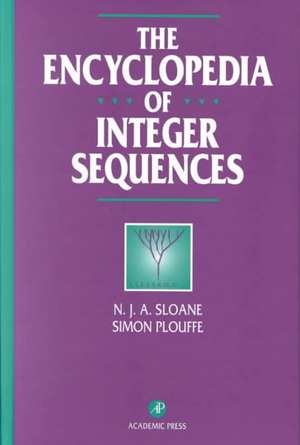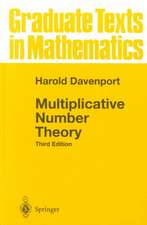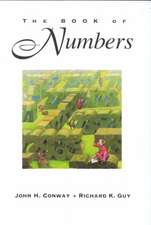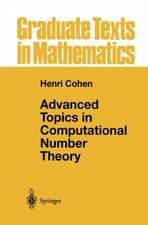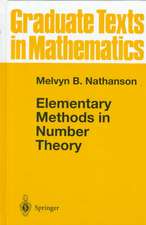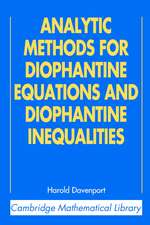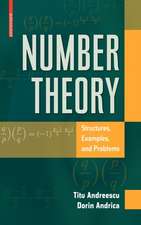The Encyclopedia of Integer Sequences
Autor N. J. A. Sloane, Simon Plouffeen Limba Engleză Hardback – 19 apr 1995
The initial chapters are both amusing and enlightening. They serve as a delightful introduction to the subject and a short course on how to identify and work with integer sequences. This encyclopedia brings Sloanes ground-breaking Handbook<$> up to date, more than doubling its size, and linking both the old and the new material to an extensive bibliography (over 25 pages long), of current and classic references. An index to all the sequences in the book is also available separately on disk in Macintosh and IBM formats.
- Contains more than 5000 integer sequences
- Gives the name and mathematical description of each sequence
- Provides citations to literature for each sequence
- Extensively cross-referenced
- Lists a bibliography of more than 25 pages
Preț: 485.57 lei
Preț vechi: 576.95 lei
-16% Nou
Puncte Express: 728
Preț estimativ în valută:
92.94€ • 100.99$ • 78.12£
92.94€ • 100.99$ • 78.12£
Carte tipărită la comandă
Livrare economică 14-28 aprilie
Livrare express 14-20 martie pentru 81.26 lei
Preluare comenzi: 021 569.72.76
Specificații
ISBN-13: 9780125586306
ISBN-10: 0125586302
Pagini: 587
Dimensiuni: 152 x 229 x 31 mm
Greutate: 0.99 kg
Editura: ELSEVIER SCIENCE
ISBN-10: 0125586302
Pagini: 587
Dimensiuni: 152 x 229 x 31 mm
Greutate: 0.99 kg
Editura: ELSEVIER SCIENCE
Public țintă
Audience: Those professionals and researchers in all areas of applied and theoretical science and engineering who need to identify and work with integer sequences, including amateurs and recreational mathematics enthusiasts, and science and mathematics libraries. Of interest to those working in: number theory, combinatronics, graph theory, discrete mathematics, computer science, algebra, geometry, communications, information theory, physics, chemistry, statistics, botany, and zoology.Cuprins
Description of the Book: Description of a Typical Entry. Arrangement of a Table. Number of Terms Given. References. What Sequences are Included? The Figures. How to Handle a Strange Sequence: How to See if a Sequence Is in the Table. If the Sequence is Not in the Table. Finding the Next Term. Recurrences and Generating Functions. Analysis of Differences. Other Methods for Hand Analysis. Transformations of Sequences. Methods for Computer Investigation of Sequences. The On-line Versions of the Encyclopedia. The Floppy Disk. Further Topics: Applications. History. Differences from the 1973 Book. Future Plans. Acknowledgments. The Table of Sequences. Bibliography. Index.
Recenzii
"In spite of the large number of published mathematical tables, until the appearance of the first authors A Handbook of Integer Sequences in 1974 there was no table of sequences of integers. The 1974 book remedied this situation to a certain extent, and the present work is a greatly expanded version of that book. The main table contains 5488 sequences of integers (compared with 2372 in the first book), collected from all branches of mathematics and science. The sequences arearranged in numerical order, and for each one a brief description and a reference is given.
An invaluable tool. I shall say no more about this marvelous reference except that every recreational mathematician should buy a copy forthwith." --MARTIN GARDNER in Scientific American
"There are twice as many sequences as there were in Sloane's Handbook and those who have the Handbook will want The Encyclopedia....Many people who have searched in vain for some of the sequences missing from the Handbook will be quick to get copies of this new and expanded version to track down these missing sequences." --RICHARD K. GUY, University of Calgary
"What's the next whole number in this sequence: 2, 4, 7, 11, 16, 22, 29? The answer can be found in one of more than 5,000 entries in The Encyclopedia of Integer Sequences." --SCIENCE NEWS
"The number of sequences cataloged here is more than double the tally of the previous incarnation....If libraries shelve this book in the reference section, they should consider aquiring a second copy for circulation. The book will likely be in high demand, not just by researchers, but by browsers at all levels who will especially appreciate the entertaining commentaries interspersed every few pages throughout the encyclopedia. Highly recommended for all academic libraries." --CHOICE
"Incomparable, eccentric, yet very useful. Contains thousands of 'well-defined and interesting' infinite integer sequences together with references for each. Sequences are arranged lexicographically and (to minimize errors) typeset from computer tape. If you ever wondered what comes after 1,2,4,8,18,71...this is the place to look it up." --American Mathematical Monthly
An invaluable tool. I shall say no more about this marvelous reference except that every recreational mathematician should buy a copy forthwith." --MARTIN GARDNER in Scientific American
"There are twice as many sequences as there were in Sloane's Handbook and those who have the Handbook will want The Encyclopedia....Many people who have searched in vain for some of the sequences missing from the Handbook will be quick to get copies of this new and expanded version to track down these missing sequences." --RICHARD K. GUY, University of Calgary
"What's the next whole number in this sequence: 2, 4, 7, 11, 16, 22, 29? The answer can be found in one of more than 5,000 entries in The Encyclopedia of Integer Sequences." --SCIENCE NEWS
"The number of sequences cataloged here is more than double the tally of the previous incarnation....If libraries shelve this book in the reference section, they should consider aquiring a second copy for circulation. The book will likely be in high demand, not just by researchers, but by browsers at all levels who will especially appreciate the entertaining commentaries interspersed every few pages throughout the encyclopedia. Highly recommended for all academic libraries." --CHOICE
"Incomparable, eccentric, yet very useful. Contains thousands of 'well-defined and interesting' infinite integer sequences together with references for each. Sequences are arranged lexicographically and (to minimize errors) typeset from computer tape. If you ever wondered what comes after 1,2,4,8,18,71...this is the place to look it up." --American Mathematical Monthly
